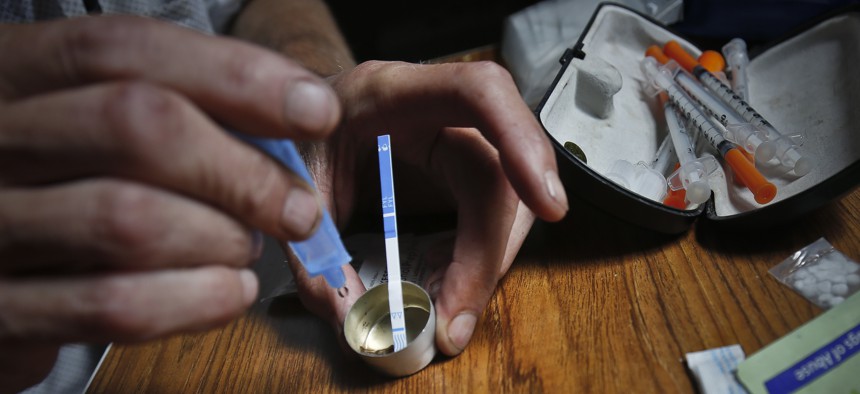The $1 Tool That Might Curb the Overdose Epidemic

An addict prepares heroin, placing a fentanyl test strip into the mixing container to check for contamination, Wednesday Aug. 22, 2018, in New York. If the strip registers a "pinkish" to red marker then the heroin is positive for contaminants. AP Photo/Bebeto Matthews

Connecting state and local government leaders
A new study shows that fentanyl test strips nudge drug users to take extra precautions.
Fentanyl, which is 50 times as potent as heroin, laces many batches of heroin and cocaine, and it is now involved in at least half of all opioid overdose deaths. More than 70,000 people died of drug overdoses last year—the equivalent of about three 747 plane crashes each week.
However, there’s evidence that a two-inch fentanyl test strip can help drug users avoid overdosing. When dipped into a drug, the strip reveals—with the presence, or absence, of a red line—whether that drug contains fentanyl. Researchers suspect that if more drug users had access to the strips, they could test their drugs and use less, or possibly not use them at all.
For a new study in the International Journal of Drug Policy, researchers from RTI International and the University of California, San Francisco, studied 125 heroin users in Greensboro, North Carolina, to see if the test strips, which were distributed through a local needle-exchange program, would change the way the individuals used their drugs. Through an online survey, 81 percent of the drug users reported using the strips, and 63 percent got a positive result for fentanyl. Those who saw the positive result were five times as likely to change the way they used a drug in an effort to avoid overdosing. They might have used less than usual, for example, or snorted it instead of injecting it, which results in less of the drug being absorbed into the bloodstream.
An earlier study by Johns Hopkins University also suggested that most injecting-drug users were interested in knowing whether their drugs contained fentanyl before using, and that they would modify their behavior if they knew.
Jon Zibbell, a public-health analyst at RTI International and an author of the study, says his paper helps build the evidence base that might lead to more funding for the test strips, even as more studies continue to be conducted. Health officials often cite a lack of scientific evidence as a reason not to implement a controversial public-health intervention.
“Harm reduction at its core is a scrappy self-made movement,” says Daniel Ciccarone, a UCSF professor who co-authored the study. “Syringe exchange and naloxone peer distribution came out of this movement and have gone mainstream. But the [test strips] need an evidence base in order to become the next intervention in this legacy.”
A few cities—including Baltimore; Philadelphia; Columbus, Ohio; and Burlington, Vermont—have started providing the test strips alongside clean needles. The California public-health department pays for the distribution of strips through needle exchanges.
But one hurdle to broader distribution is paraphernalia laws that prohibit the use of devices to aid in doing drugs. This restriction has been loosened when it comes to clean syringes, but it might still be applied to test strips. (The District of Columbia and Maryland recently exempted the strips from their definition of paraphernalia.) Zibbell predicts that test strips will start to be introduced into cities that already have progressive drug policies, such as those with long-standing needle exchanges, and will eventually flow to areas that have been more resistant to harm-reduction programs. Fifteen states still outlaw needle exchanges, for example, and Charleston, West Virginia, at the epicenter of the opioid epidemic, recently closed its needle-exchange program.
Another obstacle is the $1 cost of the strips, which can quickly balloon, since the average heroin user injects four times a day. Until the strips are more widely available, some have suggested that drug users should simply assume that all their heroin contains fentanyl, and act accordingly.
But, according to Zibbell, “that’s like saying, ‘Assume everyone you have sex with has chlamydia.’” Most people simply don’t take precautions unless the danger they face is real.
Zibbell hopes that the test strips are just a start, and that eventually needle exchanges and other sites can offer other drug-testing tools, such as spectrometers.
“We have a poisoning epidemic,” Zibbell said. “When there’s E. coli in the lettuce, you test the lettuce. You have to test the product to see what’s in it.”
Olga Khazan is a staff writer at The Atlantic, where this article was originally published.

NEXT STORY: Small Town vs. Big Pollution: Black Residents Allege Environmental Racism




